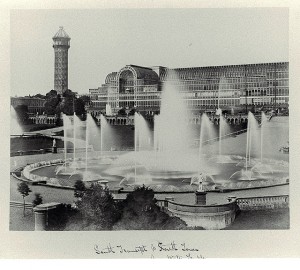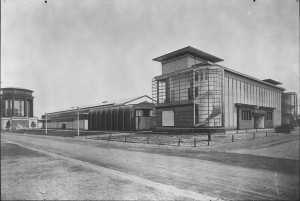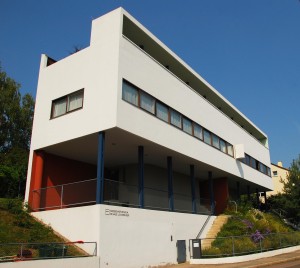Exhibitions have been extremely important in motivating progress and sharing ideas throughout architectural history. In the history of modern architecture, there have been several exhibitions that have contributed vitally to the development of modernity, both in design, theory, and engineering ability. These exhibitions include the Great Exhibition, the Werkbund Exhibition, and the Weissenhofsieldung. These three exhibitions, while separate from each other in time and location, nonetheless contribute vitally to the history of modern architecture, and illustrate the importance of the architectural exhibition.

The Great Exhibition of 1851 is a vitally important event for modern architecture because of its primary building, the Crystal Palace. This building housed the Exhibition’s main attractions: galleries showcasing the exotic cultures from the entire world. The Crystal Palace, designed by Joseph Paxton, a gardener-turned-architect, is unique in its construction and design; it was uncommon for a building in the mid-19th century to have such extensive use of iron and glass, and the building’s construction utilized a technique of prefabrication, in contrast to the building techniques of the age. 1 The building, as shown in Figure 1, consisted of numerous glass panels which covered an iron frame. The panels were all built off-site and transported to the Exhibition, which allowed the building to be constructed cheaply. In its time, the Crystal Palace was not highly regarded, but in the context of modern architecture, this building is an early example of modern technique and design.2 It is because of the early signs of a modern architecture in the Crystal Palace that the Great Exhibition is a successful and memorable event in architectural history.

Location: Cologne, Germany. Photo Credit: Unknown Photographer, 1914. Source: Harvard Art Museums
Another major exhibition in the history of modern architecture is the Werkbund Exhibition of 1914. A German architectural movement in the early 20th century, the Deutscher Werkbund placed emphasis on efficiency and industrial design. Featuring buildings such as the Factory Administration Building, designed by Walter Gropius, and the Glass Pavilion, designed by Bruno Taut, this Exhibition was a celebration of German industry and design, and manifests the growing influence and concerns of manufacturing and industrialization in architectural design, and in particular the German industrial spirit pre-World War I. 3 Gropius’s Factory Administration Building, as shown in Figure 2, merges classical and industrial styles, and in doing so symbolically elevates the status of manufacturing design, while Taut’s Glass Pavilion praises the physical and spiritual qualities of glass, creating a metaphor for Germany’s democratic tradition.4 These examples of industrial design, demonstrated at the Werkbund Exhibition, as well as the movements which surround them, such as the later Bauhaus movement, drive the development of modern architecture.
The final example of a major exhibition is the Weissenhofsiedlung of 1927. This exhibition, consisting of twenty-one houses in Stuttgart, was built for the Deutscher Werkbund and organized by Mies van der Rohe. 5 Featuring buildings by such architects as Le Corbusier, Walter Gropius, Hans Scharoun, and Mies van der Rohe himself, this exhibition is notable for its demonstration of the new International Style. Buildings in the International Style share flat, simple facades, flat roofs with terraces, long strip windows, open plans, and prefabricated construction. This is illustrated by Le Corbusier’s contribution to the exhibition, shown in Figure 3. This style does not concern itself with regionalism or building with local materials; rather, the International Style is a homogenous approach to design. 6 This exhibition is the most widely-publicized of the Werkbund’s exhibitions, and is a prime example of modern architecture reaching into the mainstream.

In sum, these three exhibitions, the Great Exhibition, the Werkbund Exhibition, and the Weissenhofsiedlung, demonstrate several architectural movements as modern architecture created a vocabulary for itself and developed new and controversial ideas.
-JH
Notes:
Figure 1: Philip Henry Delamotte, South Transept and South Tower from Water Temple. Public domain. Available at Smithsonian Institution Libraries, link (accessed November 24, 2015).
Figure 2: Factory and Office Building for Werkbund Exhibition, Cologne, 1914: Office and factory building. Public domain. Available at Harvard Art Museums, link (accessed November 24, 2015).
Figure 3: Rob Deutscher, Corbusier at Weissenhof Estate. Licensed under CC BY 2.0 via Flickr. Available at Flickr, link (accessed November 24, 2015).
- Wilson Yau, “The Crystal Palace,” Royal Institute of British Architects. Accessed on November 1, 2015. ↩
- Ibid. ↩
- “Kronik der DWB-Geschichte,” Deutscher-werkbund.de. Accessed on November 1, 2015. ↩
- “Deutscher Werkbund (1907-33),” Encyclopedia of Art and Design. Accessed on November 1, 2015. ↩
- “100 Jahre Deutscher Werkbund,” Institut für Auslandsbeziehungen. Accessed on November 1, 2015. ↩
- “Weissenhofsiedlung,” Weissenhof2002.de. Accessed on November 1, 2015. ↩
